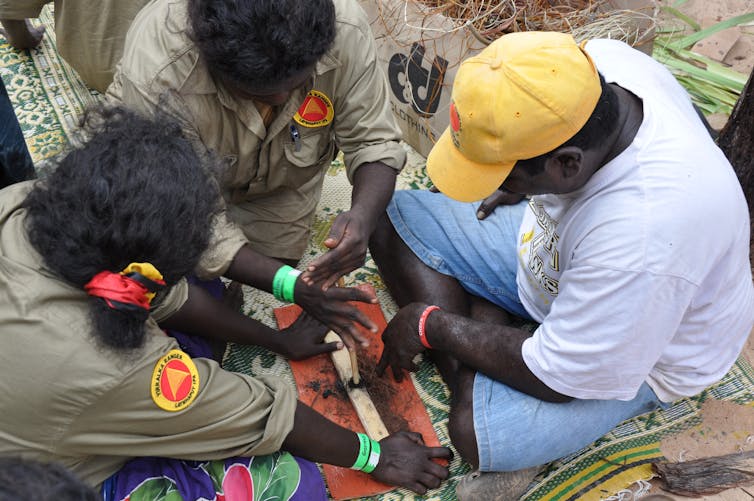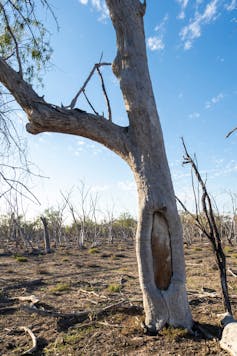Indigenous technology is often misunderstood. Here's how it can be part of everyday life
- Written by Andrew Peters, Lecturer in Indigenous Studies, Swinburne University of Technology
The COVID pandemic has highlighted our need for connection and forced billions of people to adapt to a changed world. Much of this adaptation is heavily reliant on technology, and in particular information technology, which is being used to keep many[1] people connected.
Although the pandemic is posing many problems for our modern, technological world, it also presents an opportunity to embrace ancient and valuable Indigenous knowledges and identify potential within them in different ways.
The notion of Indigenous technology is one such opportunity.
A history of Indigenous technology
Indigenous technology is a relatively misunderstood phenomenon.
This isn’t the use of technology[2] by or for the benefit of Indigenous peoples. It refers to the multiple ways that Indigenous knowledges are used to improve the lives of humans – ancient practices that have existed in various parts of the world that are still relevant, and prevalent, today
Indigenous knowledges and technology have been linked from the beginning of time. Fundamental concepts of Indigenous knowledges can and should underpin the development and role of technology in multiple ways.
These concepts include:
- relationality and connection
- reciprocity
- reflexivity
- Country
Relationality/connection refers to the Indigenous understanding of all things being connected. One action can impact many others – similar to the fundamental Western scientific concept of “cause and effect”.
Embracing and understanding reciprocity ensures the benefits of the use of technology don’t come at the expense of others (including people, plants, animals and the broader environment).
Reflexivity involves the constant cycle of learning and listening that underpins knowledge creation and transfer for Indigenous peoples and cultures. It is also seen as an important element of research and development in the world of technology (particularly relevant now as we are developing ways to treat COVID[3].
And Country refers to the grounding of knowledges in our land and all it contains. Our knowledges and languages come from the land, and this is where they belong. This makes our knowledges contextual and specific to a certain group. Understanding the specifics of a certain group is crucial to gaining cultural knowledge.
In the world of business technology, this relates to knowing and understanding your market and their specific wants and needs – a fundamental principle of marketing.
 Aboriginal woman showing the traditional bush seeds used for food and agriculture.
Shutterstock[4]
Aboriginal woman showing the traditional bush seeds used for food and agriculture.
Shutterstock[4]
Native foods and food technology
Native foods and food technology have sustained Indigenous communities all over the world for thousands of years. Today, native foods are used in a variety of ways, including connecting people with culture through culinary experiences such as the Tasmanian “Wave to Plate” project[5].
In southeast Australia, the Wurundjeri people’s name comes from the Witchetty grub found in the Manna gum that is rich in Vitamin C and good for skin wounds. Wurundjeri people still use plants such as the Manna gum (Eucalyptus), murrnong and tee tree (melaleuca) for both nutritional and medical purposes.
Native groups in North America have practised plant-based[6] medicinal practices for thousands of years, and continue to this day. This includes the direct consumption of plant parts, using them as ointments, and boiling them as part of tea drinks. Some groups also use conifer needles to create tonics rich in vitamin C for treating diseases.
Read more: 'Although we didn’t produce these problems, we suffer them': 3 ways you can help in NAIDOC's call to Heal Country[7]
Agriculture and aquaculture
Thousands of years ago, the Gunditjmara people[8] of Budj Bim in western Victoria modified natural features and created a series of artificial ponds, wetlands and networks of channels.
These practices allowed water flows between dams to accommodate the farming of eels. The Gunditjmara people also built substantial stone structures close to work sites to shelter from chilly southerly winds that can still be seen in various parts of western Victoria today.
Fire management
Indigenous cultural burning and fire management[9] is another ancient practice that lives on today.
These practises are increasingly being used as tools for national park management, emergency services and other organisations to better understand our native environment and connect with Aboriginal cultures, peoples and histories.
 Dhimarru Indigenous Rangers teaching traditional fire making at Garma Festival.
Shutterstock[10]
Dhimarru Indigenous Rangers teaching traditional fire making at Garma Festival.
Shutterstock[10]
Astronomy and geology
Traditional Indigenous storytelling has enabled modern-day scientists to discover meteorites[11] they might not otherwise have found.
And in New Zealand, geologists are continuing to use Maori traditions to better understand earthquakes and tsunamis.
Read more: Stars that vary in brightness shine in the oral traditions of Aboriginal Australians[12]
Health and well-being
Concepts of Indigenous and Western health and medicine have long differed.
Western health has primarily focused on “problem correction” and the patient’s physiology. Whereas for Indigenous people, health and well-being[13] have long included physical, mental, spiritual and environmental issues for both individuals and communities – what Western health now calls “holistic care”.
 Scar trees are formed when Aboriginal people remove sections of bark for shelters, shields, and rafts.
Shutterstock[14]
Scar trees are formed when Aboriginal people remove sections of bark for shelters, shields, and rafts.
Shutterstock[14]
Transport
Indigenous peoples have found innumerable ways to physically navigate their Country, including with the bark canoe[15], a symbol of transport technology.
Using the bark from an appropriate tree, the process today revisits ancient traditions and provides direct cultural connection for many young Aboriginal people. The prevalence of scar trees[16] in many parts of the country shows just how widespread this practice still is.
These continued uses of Indigenous technology are an affirmation of culture and history for Aboriginal peoples. It’s also a clear way for all Australians to connect with a culture that not only has a deep, deep history on our land, but continues and is still growing today.
This piece was produced as part of Social Sciences Week[17], running 6-12 September. A full list of 70 events can be found here[18]. Andrew Peters will appear on the panel discussion[19] “Indigenous Peoples and Technology” on Wednesday, September 8 at 10.30am.
References
- ^ many (theconversation.com)
- ^ use of technology (theconversation.com)
- ^ treat COVID (theconversation.com)
- ^ Shutterstock (www.shutterstock.com)
- ^ “Wave to Plate” project (www.frdc.com.au)
- ^ plant-based (theconversation.com)
- ^ 'Although we didn’t produce these problems, we suffer them': 3 ways you can help in NAIDOC's call to Heal Country (theconversation.com)
- ^ Gunditjmara people (www.deadlystory.com)
- ^ Indigenous cultural burning and fire management (www.firesticks.org.au)
- ^ Shutterstock (www.shutterstock.com)
- ^ enabled modern-day scientists to discover meteorites (theconversation.com)
- ^ Stars that vary in brightness shine in the oral traditions of Aboriginal Australians (theconversation.com)
- ^ health and well-being (www.aihw.gov.au)
- ^ Shutterstock (www.shutterstock.com)
- ^ bark canoe (museumsvictoria.com.au)
- ^ scar trees (www.aboriginalvictoria.vic.gov.au)
- ^ Social Sciences Week (socialsciences.org.au)
- ^ here (socialsciences.org.au)
- ^ panel discussion (socialsciences.org.au)

















